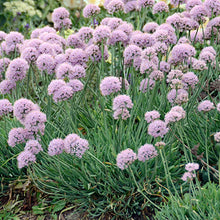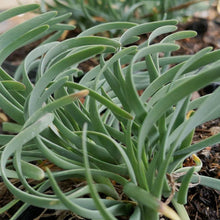Allium senescens ‘Blue Eddy’ is an eye catching native, known for its unique twisted foliage and spherical purple flower clusters. This ornamental onion is a great addition to any garden that needs a touch of drama, with its blue green foliage and late summer blooms.
Height & Spread: 12 - 18 in x 8 - 12 in
Bloom Time: Late summer (July to August)
Light Requirements: Full sun to partial shade
Soil Preference: Thrives in well drained, moderately rich soil but tolerates poor, dry soil conditions once established
Watering Needs: Drought-tolerant once established. Moderate watering is required during the growing season, but it prefers dry to moderately moist conditions
Deer Resistance: Naturally deer resistant due to its strong aroma
NATIVE STATUS
While not as widely known as other native alliums, it offers distinct ornamental qualities, with its twisting leaves and globe shaped flower clusters. ‘Blue Eddy’ is a cultivar of this native species, bred for its striking appearance and compact size.
WILDLIFE & INSECTS
Butterflies
- The fragrant flowers attract a variety of butterflies, particularly Swallowtails and Skippers. These butterflies are drawn to the vibrant purple blooms for nectar, with the late summer bloom time providing a critical food source as other flowers begin to fade.
Bees
- Bees, especially honeybees, bumblebees, and solitary bees, flock to the flowers for their nectar and pollen. This allium is particularly valuable in the late summer when many other plants are no longer in bloom, providing bees with sustenance when their foraging opportunities are dwindling.
Other Beneficial Insects
- This plant helps attract beneficial insects like ladybugs, which prey on pests such as aphids. The dense flower clusters are also perfect for predatory wasps that help keep unwanted garden pests in check.
Birds
- Seed heads offer a food source for small seed-eating birds such as finches, making this plant valuable in the fall garden as well as during its blooming period.
SPACING & LANDSCAPE USE
Spacing Recommendations
- For optimum growth, plant about 8 - 12 inches apart. This gives it enough room to grow its twisting foliage and allows for proper air circulation which helps to prevent disease.
Landscape Placement
- Works well as a border plant or in rock gardens, where its compact size and unique appearance can shine. It is ideal for xeriscaping, low water gardens, or pollinator gardens, thanks to its drought tolerance and attraction to beneficial insects.
COMPANION PLANTS
-
Echinacea purpurea (Purple Coneflower) - The daisy-like flowers provide a contrast in shape and also attract bees and butterflies.
-
Nepeta x faassenii (Catmint) - A great companion with silvery foliage and lavender flowers that attracts both bees and butterflies.
-
Lavandula angustifolia (English Lavender) - Its fragrant blooms attract bees and complements the allium’s color and structure.
-
Achillea millefolium (Yarrow) - A drought tolerant perennial that blooms in late summer and complements the late-season blooms of Allium with vibrant color.
-
Rudbeckia hirta (Black-eyed Susan) - Adds a splash of yellow and is also a pollinator favorite.
-
Thymus vulgaris (Thyme) - A fragrant herb with small pink or purple flowers that also attract pollinators, ideal for rock gardens.
-
Penstemon digitalis (Beardtongue) - This late spring to early summer bloomer offers a good early season nectar source before ‘Blue Eddy’ starts blooming.



